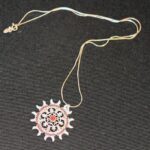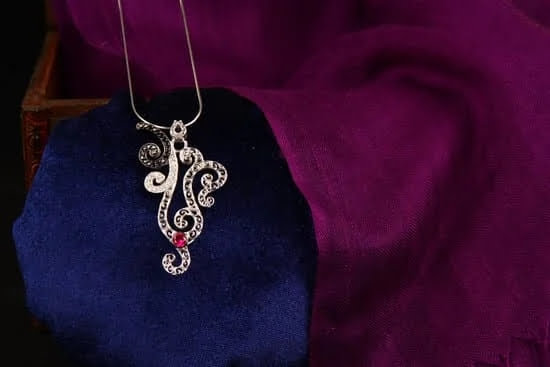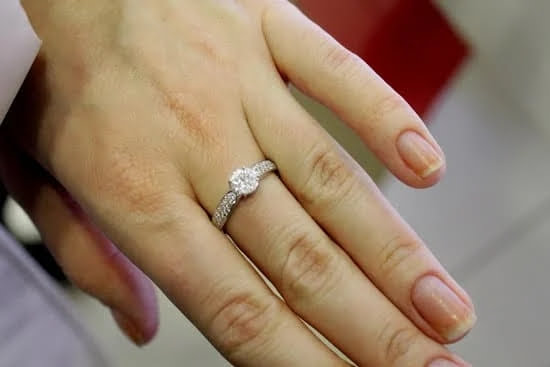Metals used in Art Deco fine jewelry may vary, but the most common ones are gold, platinum, and silver. These metals collectively evoke a sense of luxury and sophistication that has long been associated with the aesthetic of the Art Deco period.
The movement was first popularized following World War I and quickly gained traction due to its unique Art Nouveau influences. Distinctive shapes and geometric designs have become synonymous with the iconic style of art deco jewelry – creating pieces that are valuable and beautiful.
The use of precious metals such as gold and silver add to the allure of classic art deco pieces, making them ideal for wear as well as display. Gold is highly valued for its malleability which makes it perfect for intricate detailing in any piece of jewelry. Its shimmering yellow-tones further enhance its beauty – working in harmony with other colors to create a striking look.
Platinum is another favorite among art deco enthusiasts due to its inherent strength which allows for bolder designs compared to other metals available at the time. From sleek bands to gorgeous pendants and rings – this precious metal can be molded into various forms, allowing wearers to express their individuality through their accessories.
Finally, sterling silver embodies what it means to be stylishly timeless when it comes to artwork from the Art Deco era. Silver jewelry have been treasured around many cultures since ancient times, making them an exquisite choice for adding sparkles or details on large pieces or existing motifs that are already within a design.
Due to its rich finish and plentiful availability, it can often be found adorning classic rings and earrings giving off an air of elegance like no other metal can provide.
In conclusion, each one of these metals used in Art Deco fine jewelry have come into play throughout history leaving behind lasting impressions through their use – making them desirable components in this frequently sought-after style even today’s modern fashion world.
Common Metals Used in Art Deco Fine Jewelry
Most jewelry from Art Deco period is crafted from precious metals. Gold and silver are the main metals used in this era of jewelry crafting. Both have good tarnish resistance and formability, making them an ideal choice for creating settings and pieces that are sure to dazzle. Platinium was also introduced in the mid 1920s, becoming a popular choice due to its ability to hold intricate details with minimal reinforcement needed.
Gold has been used since ancient times and it’s no surprise that it’s still a favorite among jewelry makers today. The sheen of gold results in an elegant look against a person’s skin, which has made it remain fashion conscious throughout the ages.
Gold also doesn’t oxidize or corrode when exposed to air, making it well-suited for use in rings and pieces that require more frequent contact with air. The most commonly used alloy of gold is 18-karat yellow gold – but white gold came onto the scene during the Art Deco period, bringing another finish option for creating stunning pieces filled with gemstones like diamonds, sapphires or rubies.
Silver had long been considered a less expensive substitute for gold until the Sterling silver standard was introduced in Britain during the 12th century by King Henry II. They set down laws dictating what constitutes as “Sterling” – 92/5% pure silver and 7/2% copper – making it easier for people to know what they were buying when shopping for silver jewelry pieces or other items made from silver alloyed with base metals such as copper.
Silver is easily malleable and can be hardened if desired which makes it a great option for more elaborate designs featured on brooches, necklaces and earrings during the Art Deco era. Silver also provides a matte finish while holding a higher luster than other base metals allowing artisans to craft beautiful works of art with fine detailing unfamiliar before this time period.
Platinum is more durable than both gold and silver but not usually found in coinage until much later on due its higher expense at the time. Due to its weight and strength, platinum became popular in heavier jewelry styles allowing designs enhanced with detailed engravings that won’t wear away due to contact over time nor brassy become discolored after being exposed to sweat or cosmetics.
This enabled jewelers of the Art Deco Period to create larger statement pieces with intricate piercing movement without sacrificing on strength yet these pieces still remained lightweight enough for comfortable everyday wear which saw an uprising in popularity during this time period.
The Development of Unique Metals Used in Art Deco Jewelry
Art Deco jewelry is often associated with sophistication and class due to its streamlined lines, geometric designs, and lavish use of expensive materials. One of the hallmarks of Art Deco fine jewelry is the utilization of rare and precious metals as part of the overall aesthetic.
These luxurious metals reflect a certain amount of status in addition to being aesthetically pleasing, hence their popularity during this period. This article will explore some of these metals and their uses in Art Deco jewelry.
One of the more unique metal found in Art Deco jewelry is coral. Not only does coral lend itself nicely to bold geometrical shapes but it also provides an artistic contrast when paired with other metal such as gold or platinum.
Coral was so popular that there were entire lines dedicated solely to producing pieces with this high-end material. In addition to unique shape qualities, coral also came in multiple colors including pink, white and red making it easy for wearers to find pieces that fit with their individual style preferences.
Another exotic material found in Art Deco fine jewelry is turquoise which was used for detailed designs that had intricate carved patterns or imprints affixed onto them. It should be noted that genuine turquoise stones remain quite expensive even today due to their rarity value; thus why they have remained highly sought after among collectors worldwide.
Semi-precious stones like moonstone, opal and amethyst were also popular during this era as they provided interesting textures and flashes if light when set against precious metals such as gold or silver creating aesthetically pleasing pieces that could last a lifetime if given proper care.
In conclusion, aggressive use of rare materials like coral, turquoise, semi-precious stones along side precious golds helped make Art Deco jewelry truly one-of-a-kind pieces that far outshine items made with contemporary materials today. With their bold designs showcasing masterful craftsmanship plus intricate detailing on unique materials said items are sure to keep collector’s attention for many generations to come.
Jewelry Making Techniques of the Art Deco Era
Art Deco fine jewelry was an art form characterized by a blend of traditional craftsmanship and modern expression. Making use of a variety of diverse metals, jewelry makers could create intricately detailed pieces that range from bold geometric designs to creative enameled motifs.
While gold and platinum remain popular materials in Art Deco designs due to their strength and durability, silver, brass and bronze have become much more accessible in recent years – allowing for more options when creating vibrant Art Deco jewelry.
The traditional Metalsmithing techniques used during the Art Deco movement allowed for many ways to finesse pieces with intricate detail and design elements. Repoussé, for example, is a method used to work piece sheet metal from the reverse side with a hammer – which helps create a thinner sheet with relief details that can then be adorned further.
Chasing is another technique employed frequently in creating these unique pieces, with textures often created by shaping various surfaces into crescents or waves against the main design on the surface of the jewelry item itself.
Finally, Enameling was frequently used during this era due to its ability to lend strong color effects to items as well as its durability – making it great finish that remained strong throughout long-term wear or through affixment onto fabrics fashion items such as dresses or hats.
Jewelers primarily worked with cloisonne enamel which involves pouring or painting multiple layers of colored materials onto flat spaces distributed across different sections of whatever objects are being enameled – providing an incredibly colorful effect that was unique to each piece crafted whether it be brooches, earrings or bracelets.
The Allure of Art Deco Fine Jewelry
Art Deco jewelry is renowned for its timeless beauty and sense of luxury that many people around the world covet. Each piece is marked by symbolism and a story reflective of its creator’s intent and purpose. From design to materials, Art Deco Jewelry is made with the finest craftsmanship. Its unique characteristics make up a style that transcends today’s trends to become an heirloom truly cherished by those who own it.
The metals used in Art Deco fine jewelry must meet a high standard of quality to truly embody the spirit of this classic period style. Gold is one metal used to create intricate pieces with delicate workmanship. It symbolizes wealth, power, and everlasting love due to its attractiveness, strength, durability, and malleability; making it the perfect choice for jewelry that a family can pass down through generations as an heirloom.
Platinum is another popular choice amongst designers; known for its rare properties found in gleaming white jewelry pieces. It’s aesthetic appeal comes from its natural whiteness which creates modern yet classic styles patients admire year after year.
The Deco period has seen a resurgence in appreciation recently due to its ability to adapt into new fashion trends while still upholding traditional ideals of craftsmanship. Palladium is one metal used more often because of its subtlety when paired with other colors like yellow gold creating dynamic designs brimming with distinction and high quality jewels that holds its value over time even if not kept as an heirloom piece.
Silver was also often mixed with various gemstones such as amethyst or topaz for bolder designs during this era but still remains a popular choice among designers for affordable yet stylish everyday wear options available on many high street shops today.
Each metal reflects upon the feeling imbued within each piece created during this period and offers something treasured across many eras by both women and men alike; proving just how versatile these beautiful charms can be.
The Current Market for Art Deco Fine Jewelry
The market for Art Deco fine jewelry is vibrant and growing, thanks in large part to an increased appreciation of the clean lines and geometric motifs that characterized this period of jewelry making. Discreet but powerful, well-crafted pieces from this era have become increasingly popular among online stores, collectors, elite trendsetters and forward thinking fashionistas.
Of course art deco pieces can often be harder to come by – which only adds to the unique appeal of these classic yet modern styles.
One key factor in the continued success of Art Deco fine jewelry is the range of metals used to craft these designs. Historically; yellow gold, white gold and platinum were used for these pieces – with diamonds set in platinite (an alloy that contains both platinum and palladium in equal parts). Although silver was also occasionally used it was never seen as a high-end metal and was more typically associated with costume jewelry.
Nowadays though; modern metals such as titanium, stainless steel or even tungsten are being employed to create new pieces of Art Deco fine jewelry – bringing with them a fresh perspective on design. Not only do these new materials offer additional possibilities for innovative design, but they have allowed many people who previously couldn’t afford traditional precious metals to join the ranks when it comes to flaunting beautiful vintage style bling.
The combination of vintage aesthetic elements along with updated materials make Art Deco jewels ideal choice for trend setting fashionistas all around the world.
Rekindling the Passion for Art Deco Jewelry
Art Deco fine jewelry is making a comeback in fashion today, and for good reason. The geometric designs of the 20th-century modernist movement have captured the world with its bold yet sophisticated style. Art Deco pieces are designed to make a strong statement, from gold and diamond necklaces to classic diamond solitaire rings that exude classic glamour.
But what exactly makes these pieces so special? It’s all in the metal. Art Deco isn’t just limited to diamonds; it’s complete with fine metals like platinum, gold, white gold and even rose gold.
Platinum is the star player when it comes to Art Deco jewelry, as this precious metal was popularized during the early 1920s. Its unique greyish hue gives jewelry a striking look and a timeless appeal that will never go out of style.
Platinum also has superior durability when compared to gold, meaning that your vintage Art Deco jewelry won’t tarnish over time or fade easily from wear and tear like other metals would. Platinum jewelry typically comes crafted in yellow or white gold settings which provide a further interesting contrast.
Gold is typically featured on 90 percent of Art Deco Jewelry due to its luxurious sheen which radiates sophistication and decadence; it embodies the undying aesthetics of classical beauty and wealth. Within that 90 percent, yellow gold takes center stage: it produces a glamorous finish on classic wedding bands as well as intricately designed bar pins decorated with colorful gemstones or artfully intertwined strands of white and yellow metal for dramatic necklaces.
White gold remains an excellent choice for customers who prefer subtle detailing because there’s nothing more elegant than two-tone necklace pendants encrusted with diamonds set into white gold accents against a backdrop of yellow gold bezels.
Finally we come to rose gold: one of the most contemporary metals ever seen in fine jewelry design and ideal for adding feminine flair without compromising on style, strength or longevity. While yellow gold suits all skin tones, rose gold looks especially great on darker complexions since its pinkish hue complements darker skin tones really well – so if you’re rockin’ dark skin then this might just be your new go-to metal.
Whether it’s slim wedding bands adorned with pave diamond accents or double stone cocktail rings featuring colored gemstones accentuated by milgrain detailing along the edge – rose gold adds just enough bling without getting too flashy; perfect if you’re after something subtle yet sparkling.
Conclusion
Art Deco fine jewelry is a popular choice for many fashion-forward jewelry enthusiasts. During the Art Deco era in the 1920s and 1930s, this style of jewelry became incredibly popular, with its use of geometrical shapes, clean lines and bold colors. It was quite revolutionary in terms of design. What added to this distinct style were the different metals used to craft unique pieces that embodied the motifs associated with this movement.
The most iconic metal used in Art Deco fine jewelry is platinum. Platinum has a silvery-white sheen which makes it perfect for reflecting light and providing an eye-catching look. Additionally, this metal can withstand tarnishing which makes it ideal for those looking for something durable or heirloom quality pieces. White gold was also used because it retained much of the same shine as platinum, but offered up a more affordable alternative.
Alongside white metals, yellow gold was also used by designers to create statement pieces that would stand out among other types of jewelry from that era. The yellow hue provided extra warmth across designs and allowed for intricate details to stand out even better than with pure silver or platinum pieces.
In conclusion, art deco fine jewelry remains highly sought after among many collectors today due to its timeless appeal and intentional combination of design elements often seen through the use of different metals like platinum, white gold, and yellow gold. These bold yet classy details are what helped define this art movement’s success as they created unique accessories that anyone could appreciate even almost a century later.

Welcome to my jewelry blog! My name is Sarah and I am the owner of this blog.
I love making jewelry and sharing my creations with others.
So whether you’re someone who loves wearing jewelry yourself or simply enjoys learning about it, be sure to check out my blog for insightful posts on everything related to this exciting topic!





